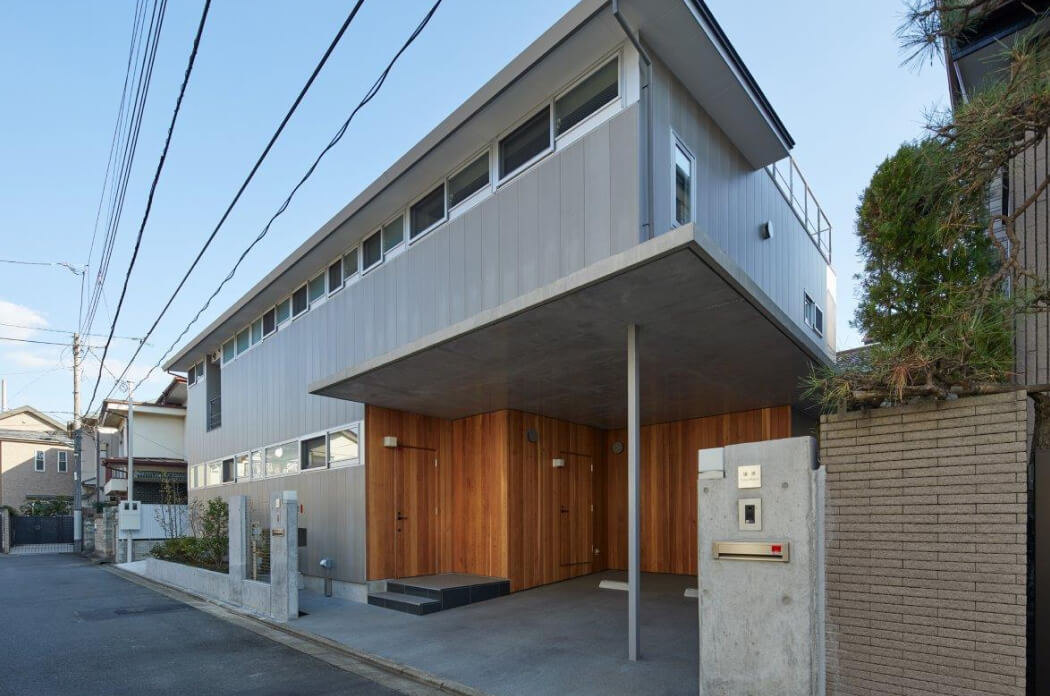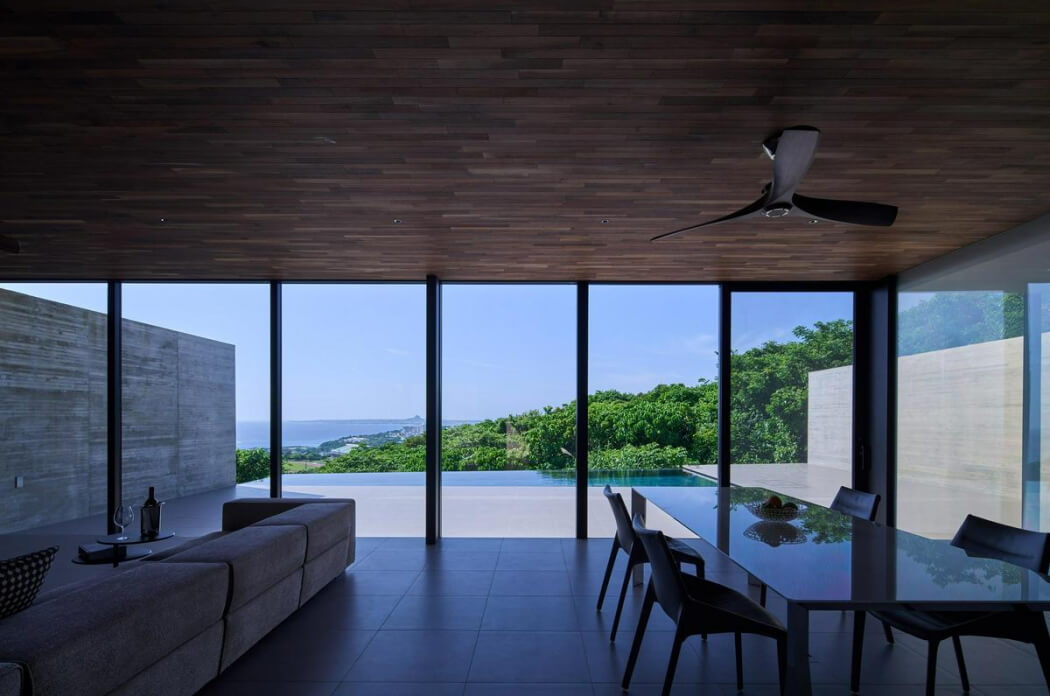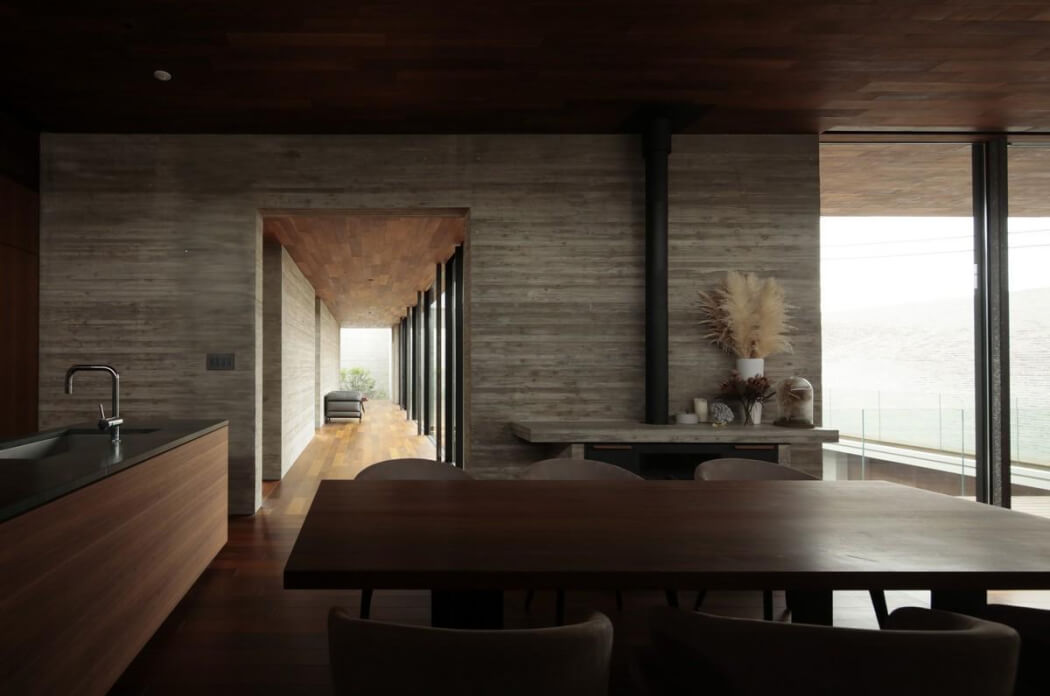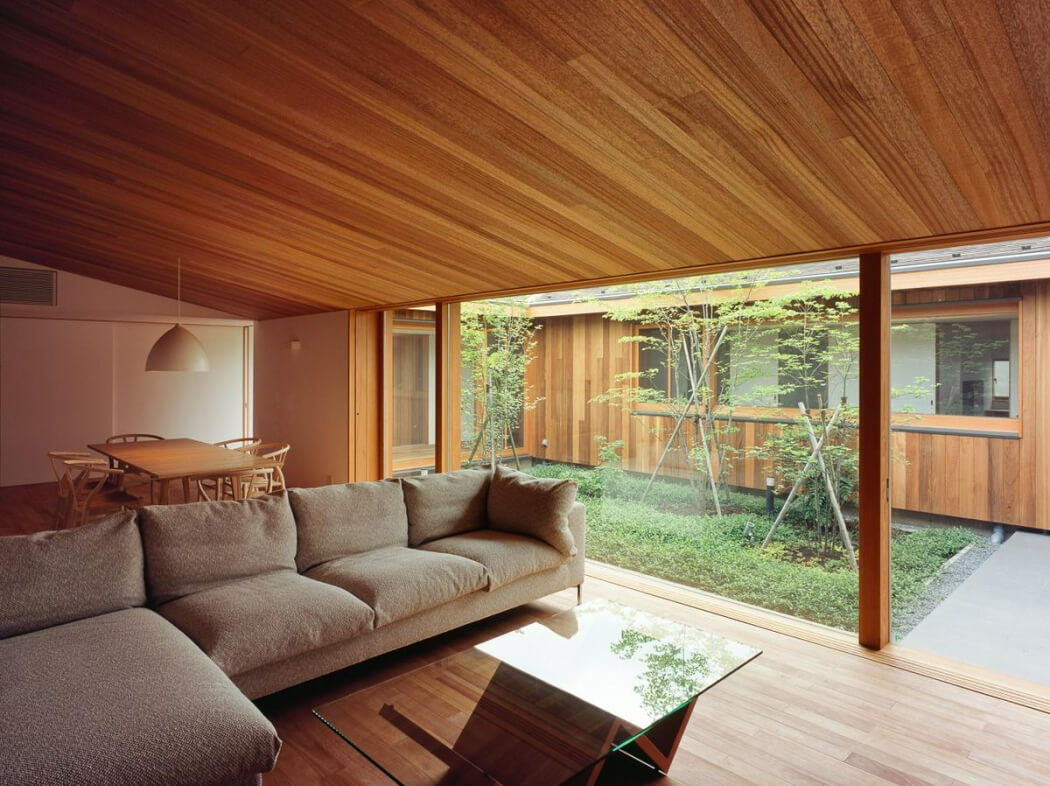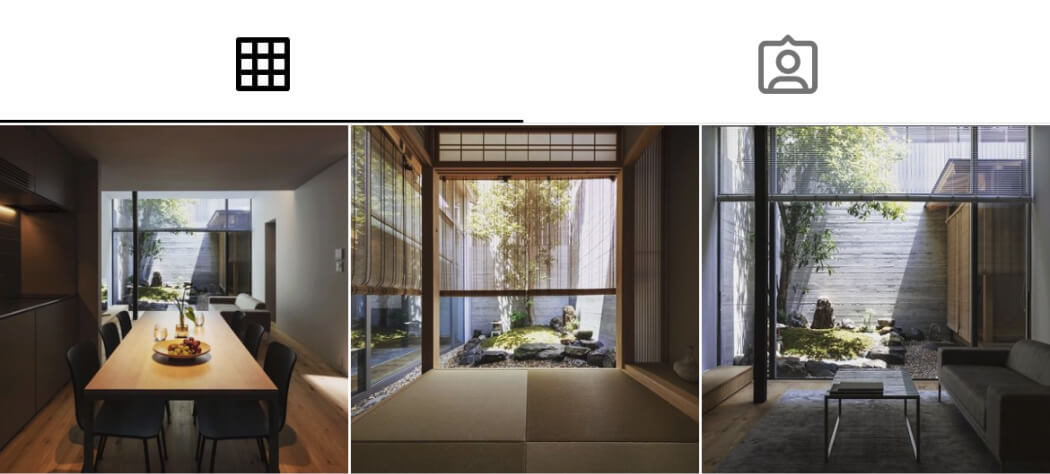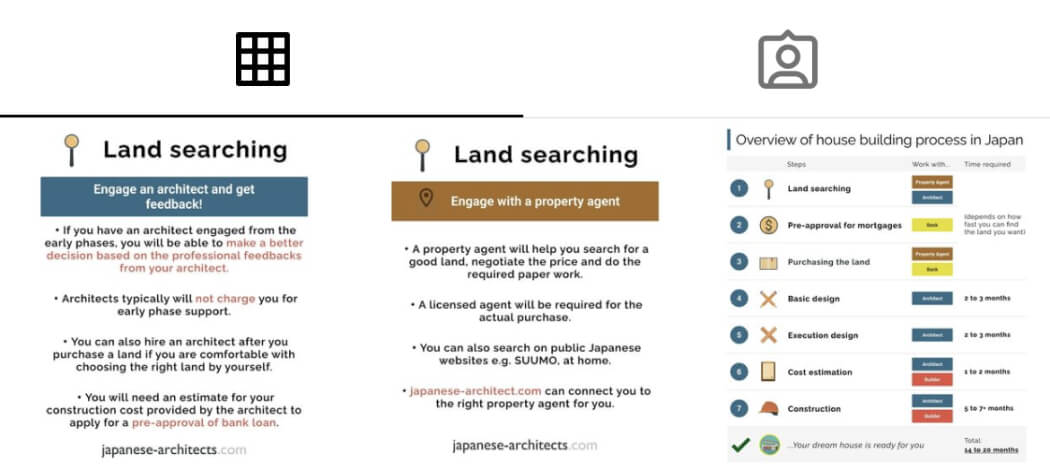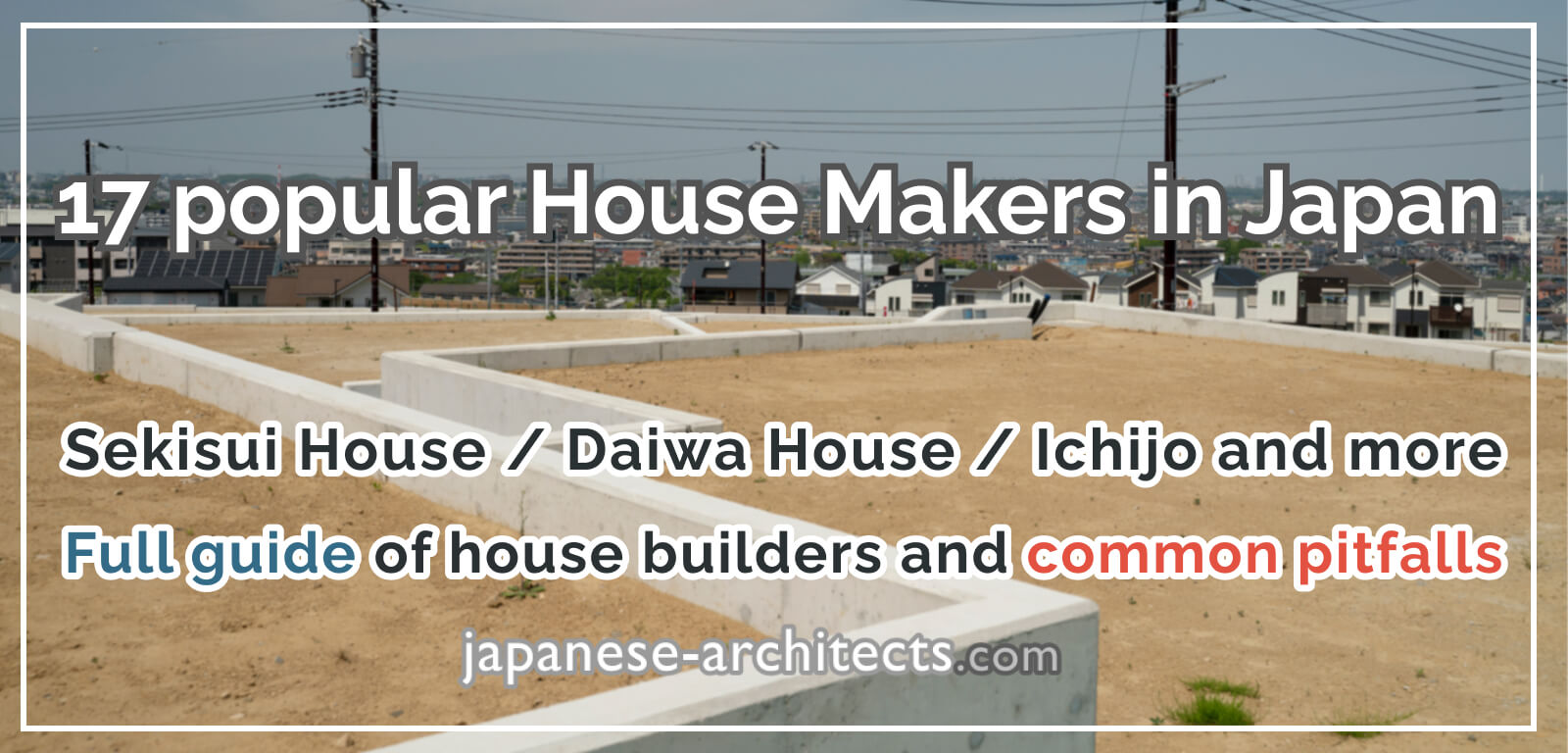
Sekisui House? Daiwa House? Review of 17 popular "house-makers" in Japan
Building your house is one of the most expensive events in your life and the last thing you want to do is to choose the wrong partner who can not deliver the house you wanted, or worse, regret for decades only after you built it with them.
It is one of the popular options to build your house with a "house-maker" in Japan. There are more than 40 companies, ranging from major national companies to low-cost house manufacturers. You may have started looking for the right company to build your house with but are confused with the enormous information available on the internet and don't know how to choose the right one.
Below is a quick summary of this article:
- You can build a house in Japan with a house-maker, a local builder, or an architect.
- You can choose your house-maker based on budget, design, functionality, and English capability. Each house-maker has strengths in different construction types and budget ranges.
- Local builders are usually the cheapest choice, architects are the choice with the most freedom and design, and house-makers are in the middle.
In this article, we will first describe the overview of your house-building options in Japan and general criteria for how people choose their house-makers. Later in the article, we will review the features of 17 popular house-makers in Japan, as well as the common pitfalls you may want to avoid.
Table of Contents
- 1. What are my choices of builders in the first place?
- 2. What is a "house-maker"?
- 3. How to choose the right builder
-
4. Review of the 17 popular house-makers in Japan
- 4-1. Sekisui House (積水ハウス)
- 4-2. Sekisui Heim (セキスイハイム)
- 4-3. Sumitomo Ringyo (住友林業)
- 4-4. Tama Home (タマホーム)
- 4-5. Daiwa House (ダイワハウス)
- 4-6. Misawa Homes (ミサワホーム)
- 4-7. Mitsui Home (三井ホーム)
- 4-8. Hebel Haus (ヘーベルハウス)
- 4-9. Ichijo Komuten (一条工務店)
- 4-10. Panasonic Homes (パナソニックホームズ)
- 4-11. Toyota Home (トヨタホーム)
- 4-12. Eyeful Home / LIXIL Group (アイフルホーム / LIXIL グループ)
- 4-13. Aida Sekkei (アイダ設計)
- 4-14. Sweden House (スウェーデンハウス)
- 4-15. Aqura Home (アキュラホーム)
- 4-16. Cleverly Home (クレバリーホーム)
- 4-17. Universal Home (ユニバーサルホーム)
- 5. Things to watch out for and 5 common pitfalls
- 6. Summary
(1) What are my choices of builders in the first place?
First of all, there are 3 major options when you want to build your house in Japan; house-makers, local builders (工務店, "Komuten", and architects. Here is a quick overview of the pros and cons of each builder:
Read the full article to know the details of each comparison or get in touch with a professional for live consultation for free.
(2) What is a "house-maker"?
It may sound weird to many people as one of the Japanese-made English words (or Engrish), ハウスメーカー, or house-makers, are large corporations in Japan whose main business is mass manufacturing of standardized houses.
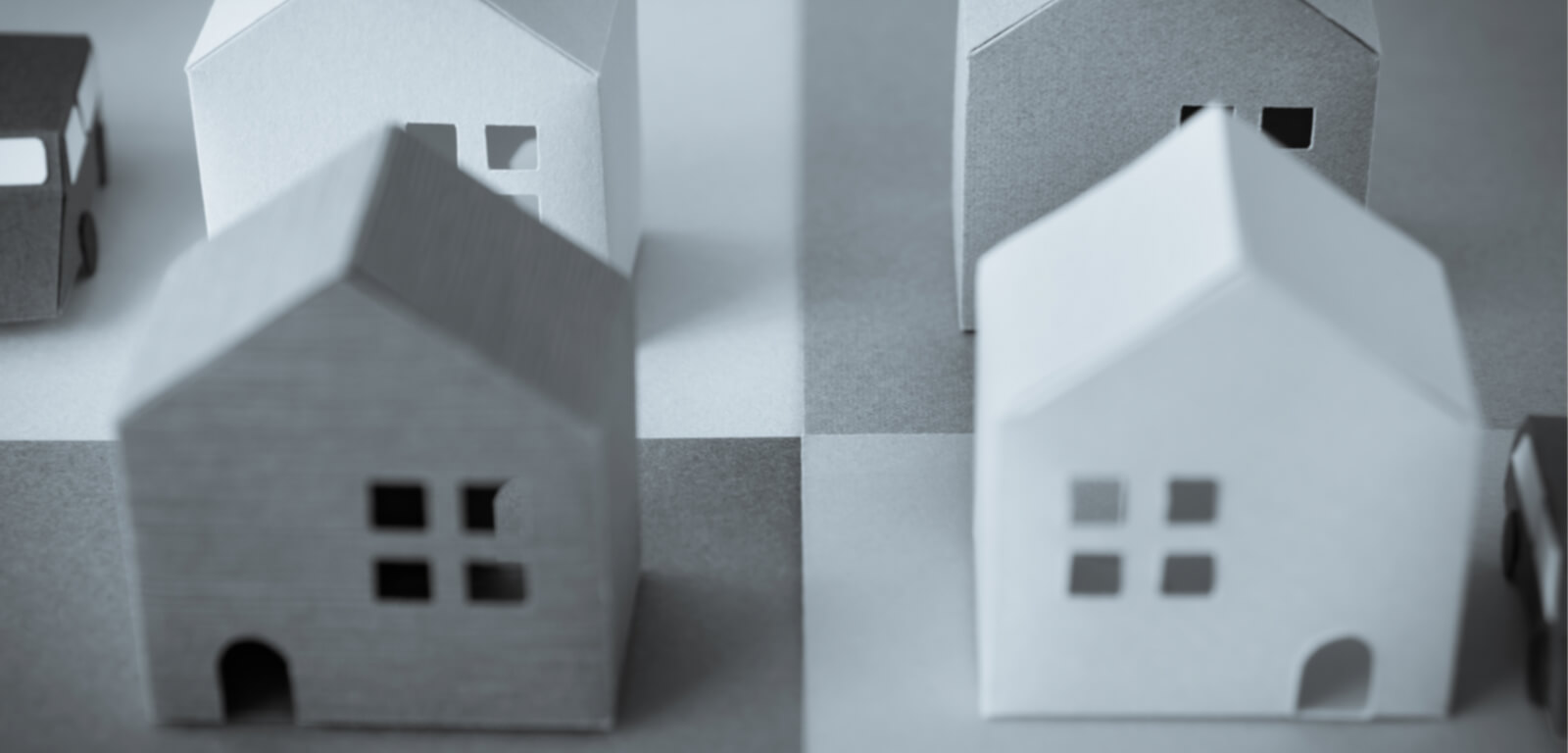
The business model is to run mass marketing with TV commercials and model houses and acquire a large number of clients with similar needs across the country. To deliver houses to a mass population, the products are optimized to the common lifestyle and family needs in Japan.
You will be able to benefit from the cost efficiency of mass production if you like the very product you see on their catalogs.
On the other hand, once you start changing the elements from their standardized plans, the cost will surge as it will fall out of their business model and capability.
(3) How to choose the right house builder
Here are the "6 points" you must consider before choosing your house builder when you want to build a house in Japan.
3-1. Choose based on your budget
Each house-maker has a typical price range they are used to building. As their business is producing a standard model that fits a specific set of users, they aim to target a specific price range.
Some companies target customers with lower budgets and offer products that have minimum functionality and keep the cost very low. Some target wealthier customers and offer house products that have better functionalities and designs at a higher price. Please see Section 4: Overview of the 17 popular house-makers in Japan for the details of each house-maker.
Related article: How much does it cost to build a house in Japan? Key things to know

Key Knowledge: Construction Cost per Tsubo (坪単価)
You will hear many people say tsubo-tanka when you start considering building your house. Cost per tsubo, or 坪単価, is a unit to measure how much your house will cost per certain size of floor area. 1 tsubo is equal to 3.3 square meters. When you hear “1 million yen tsubo-tanka”, it means that your house will cost 1 million yen per 3.3 square meters of the total floor area of your house.
The important thing to know is that the definition of tsubo-tanka is different between local builders and architects, or even with different house-makers. Some tsubo-tanka will look smaller if it does not include many of the ancillary works, including air conditioning systems, lighting, outdoor facilities or water supply works.
You need to keep in mind that the tsubo-tanka is not apples-to-apples among builders and think about the total cost you will need. When you are speaking to a house-maker, make sure you confirm what is not included in the original quote; some will say "別途" (not included) on the initial list and will cost you material money later on.
Don't forget about the "other expenses"
Although the cost of your building and the land will be the major portion of your entire budget, you will also need to pay attention to the other expenses when it comes to choosing the right builder.
Other expenses could include registration fees, agent fees, survey fees, landscape costs, and more. as previously described, it is important to compare your house-maker options based on the total cost of what it takes to build the house you want, not the convenient "tsubo-tanka (坪単価)" they present you for sales purposes.
- The market average of other expenses of building a single-family house in Japan generally ranges from 10% to 20% of the total amount of land and construction cost.
- There are mainly five major phases in which you will have to pay different items of miscellaneous expenses.
- Some of the ways to save other expenses are to use bridge loans or installment loans when applying for a house loan with a bank and to ask your architect to include expenses of furniture and appliances in the construction budget.
Related article: What are the other expenses of building a custom house in Japan?
If keeping your cost as low as possible is your highest priority over designs, functionality, and everything else, local builders (工務店, Komuten) are the typical choice. Builders offer similar services and products as house-makers but don't spend as much advertising cost as they do, and the cost tends to be lower than houses built by house-makers and architects.
3-2. Choose based on the construction type
There are three types of construction types; wooden, steel frame, and reinforced concrete. Each construction has its own advantages and different house-makers do/don't offer certain products.
| House type | Major pros and cons | Average price (rough ballpark)* |
|---|---|---|
Wooden / Timber House  |
・Relatively cheaper ・Good ventilation ・Lower soundproof etc. |
・JPY 0.8~1.2 million per tsubo (坪) |
Steel Frame House 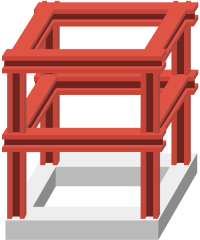 |
・Stronger build ・Faster construction ・Lower flexibility in ovation etc. |
〜 (in between) 〜 |
Reinforced Concrete (“RC”) House 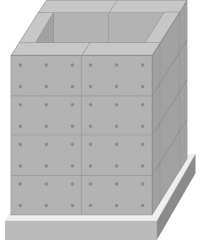 |
・Strength and flexibility ・Soundproof ・Higher price etc. |
JPY 1.4〜1.8+ million per tsubo (坪) |
*The price will depend on where / how / with who you are going to build. Please check with a professional upon construction. |
Wooden house

Wooden construction is the most common method in Japan-based. It is easy to keep the construction cost low and you will be able to see a wooden house in most of the house-makers as their products.
Benefiting from the abundance of timber in Japan since ancient times, wooden construction techniques developed in constructing temples and shrines, and they came to be used for residential houses as well. Today, most houses in Japan are built of wood, accounting for about 90%* of all single-family houses in Japan.
Major advantages of wooden houses are:
- Easy to be demolished or renovated
- Construction costs are lower than those of steel or concrete structures
- The statutory useful life is 22 years (for the economic depreciation period)
- High moisture absorption and retention
- Excellent heat insulation properties
If you are looking for a better quality or design than average house-makers, hiring your own architect is also a common option in Japan. You can start by contacting us for free consltation and be connected to a suitable architect who can design your ideal wooden house from scratch.
Related article: A guide to wooden houses in Japan

Steel frame house

Steel construction refers to a construction method that uses a steel frame to construct the framework of a building, such as columns and beams. The steel structure is also called "S造" in Japanese, which is taken from the first letter of the word "steel”.
In Japan, traditional houses made of wood are still very popular, yet recently, sturdy houses made of steel are also attracting attention.
Steel construction is characterized by its wide range of applications. It is used not only for detached houses, but also for apartments, condominiums, and buildings where greater strength is required.
Major advantages of steel frame houses are:
- Higher earthquake resistance
- Less subject to the constraints of columns and bearing walls during planning, allowing for a higher degree of freedom in design
- Free from termite damage
- Longer endurance period
- Shorter construction period as the materials are manufactured in a factory and then assembled on site
Related article: A guide to steel-frame houses in Japan
Reinforced concrete house

Reinforced Concrete ("RC") construction refers to the construction of buildings using reinforced concrete. In the construction process, reinforcing bars are assembled at the construction site to form the framework for the columns and walls, which are then surrounded by plywood and other materials known as formwork, into which concrete mixed at the plant is poured and hardened.
In this way, the building is formed one floor at a time. RC construction offers a high degree of freedom in design and is often used in high-end custom-built houses where the owner wants to create a house of his or her own original design because it is easy to construct large spaces.
The nature of concrete makes houses a durable, long-lasting material choice. It resists erosion, fire, rotting, and rusting, and with relative ease. Concrete can be cast into any desired shape. It also has a lifespan that exceeds many other types of building materials.
On the other hand, concrete houses are more expensive to build than wooden houses because concrete typically costs more than wood.
Also, it is important to be aware that concrete sweating can happen when warm air comes into contact with a cooler concrete slab and it causes the concrete floor to sweat.
See more details of this house
Generally, people who want to build their houses in concrete tend to hire an independent architect, not build with a house-maker who sells mass-produced products.
Architects will design the house from scratch based on the client's wants and fit it flexibly within the budget with sophisticated designs. Please contact our staff for free if you want to have a free consultation and be connected to a suitable architect for you.
Related article: A guide to concrete houses in Japan
3-3. Choose based on the design
If the design of your own home is important to you, take a look at the website of each company and get their product catalogs mailed to you. You can see what types of products they produce and what kind of design each company is good at.
The important thing to note is that it will be your best option if you can find the exact design you want in a product catalog but it will be costly if you think you want to change the designs or plans that are shown in the catalog. Please see Builder comparison: Cost for details about the best cost strategy and which builder to choose.
See the works by our architects if you are looking for better aesthetics or one-of-a-kind designs developed from scratch based on your wishes.
See more details of this house
3-4. Choose based on the functionality and performance
Although most of the house-makers have similar product offerings, each company is trying to differentiate itself by developing unique functionalities. Some focus on earthquake resistance, and some on thermal technologies. Please see Section 4: Overview of the 17 popular house-makers in Japan for the details of what each house-maker is good at.
Earthquake resistance
If you want to build a house that is resistant to earthquakes, we recommend that you choose a house-maker that offers a "level 3" earthquake resistance rating (耐震等級). Earthquake resistance rating is on a scale of 1 to 3, with a higher number indicating greater earthquake resistance.
Level 1 is defined as the level of earthquake resistance that prevents a complete collapse in an earthquake with the same intensity as the Great Hanshin-Awaji Earthquake (阪神淡路大震災, seismic intensity 7), while level 3 can withstand an earthquake 1.5 times stronger than the Great Hanshin-Awaji Earthquake).
Thermal insulation
There is also a level of thermal insulation of houses (断熱等性能等級) which is indicated on a scale of 1 to 7. Higher grades will have better thermal insulation performances. It is usually said you want to have a thermal insulation level of 4 or higher if you want to keep keep your house cool in the summer and warm in the winter.
Although the grades indicate certain performances of your house, it is also important to ensure how you actually feel and how comfortable the space can be in reality. Make sure to talk to an architect to achieve a comfortable environment for you, not just chase for a higher grade on paper.
People who are not satisfied with the functional quality of the house-makers and want to aim for better quality tend to choose architects as their option. Same as aesthetic design, architects are also capable of designing the functionality and strength of the house as the client wishes.
You can get in touch with an English-speaking professional for free if you want to learn the process and get connected to a suitable architect for you.
3-5. Choose based on the sales representative
When selecting a house-maker, it is important that your sales representative is someone you can trust. If the sales representative is not trustworthy, you may end up with a house that is far from the original plan that was presented to you before the contract signing.
It is important to investigate if the sales representative in charge has sufficient knowledge and experience. If they do not have at least 3 or more years of experience, they may not have experienced enough cases to guide you through the process without major troubles.

To find out how good your sales representative is, you may want to ask several questions like "How long have you been working in this industry?", "How many clients have you supported so far?", or "What kind of houses and clients were you in charge of recently?".
See also Section 5: Things to watch out for and 5 common pitfalls for common troubles with house-makers and sales representatives without sufficient experience.
3-6. Choose based on English capability
Unfortunately, not many house-makers in Japan have sales representatives or architects who can speak English. Even if they rarely did, there is not a good chance he/she can actually be your full representative in charge.
japanese-architects.com offer full English support throughout the process for non-Japanese people who want to build their houses in Japan. Learn more about the service or get in touch with a professional to get started for free.
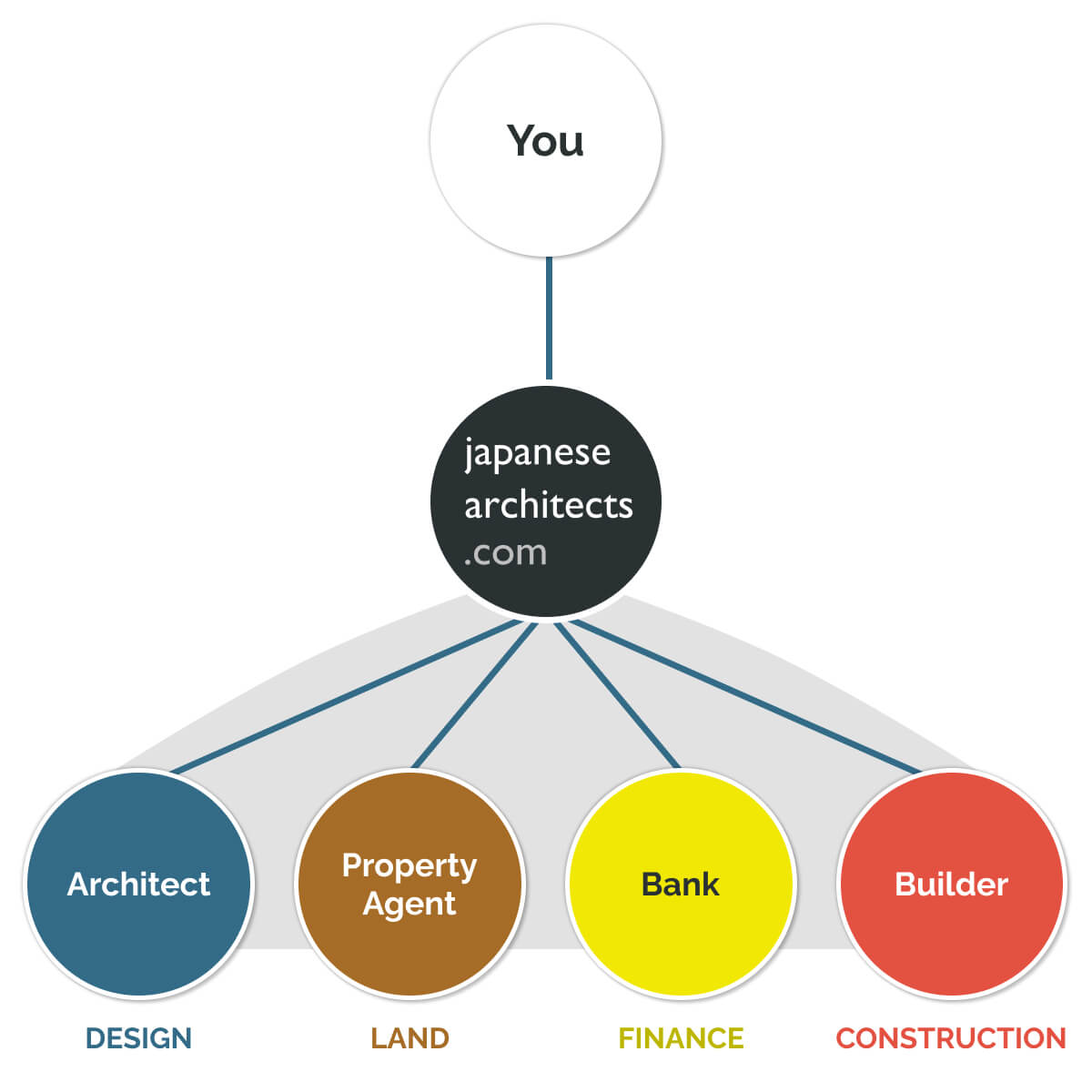
(4) Review of the 17 popular house-makers in Japan
Here is the list of 17 popular house-makers with the main construction types they deal with and the budget range they typically offer.
| House Maker | Wooden House? | Steel Frame? | Concrete? | Budget Range |
|---|---|---|---|---|
| Sekisui House (積水ハウス) |
High | |||
| Sekisui Heim (セキスイハイム) |
Middle | |||
| Sumitomo Ringyo (住友林業) |
High | |||
| Tama Home (タマホーム) |
Low | |||
| Daiwa House (ダイワハウス) |
High | |||
| Misawa Homes (ミサワホーム) |
Middle ~ High | |||
| Mitsui Home (三井ホーム) |
Middle ~ High | |||
| Hebel Haus (ヘーベルハウス) |
High | |||
| Ichijo Komuten (一条工務店) |
Middle | |||
| Panasonic Homes (パナソニックホームズ) |
Middle | |||
| Toyota Home (トヨタホーム) |
Low ~ Middle | |||
| Eyeful Home (アイフルホーム) |
Low | |||
| Aida Sekkei (アイダ設計) |
Low | |||
| Sweden House (スウェーデンハウス) |
Middle ~ High | |||
| Aqura Home (アキュラホーム) |
Low ~ Middle | |||
| Cleverly Home (クレバリーホーム) |
Low | |||
| Universal Home (ユニバーサルホーム) |
Low |
We will review the key features of each house-maker one by one. Please visit the official website of each house-maker or contact a professional if you want to know more details about a specific house-maker.
4-1. Sekisui House (積水ハウス)
A house-maker with a track record of over 2.5 million houses, focusing on unique construction methods and technologies.

- Main construction type: Wooden, Steel Frame
- Budget range: High
With its headquarters in Osaka, Sekisui House has built over 2 million houses since its inception. The company features a wide lineup of both wooden and steel-frame houses. Sekisui House Japan focuses on high flexibility and environmentally-friendly technologies.
Sekisui House Japan is also known for its unique construction method with high earthquake resistance. It develops its own technology called "シーカス" which limits the damage even in the event of a major earthquake as big as magnitude 7.
Sekisui House also offers steel-frame houses which they call "dynamic frame system" that has high earthquake resistance and larger width between the beams.
4-2. Sekisui Heim (セキスイハイム)
Focus on factory-produced prefabricated houses and energy-efficient technology.

- Main construction type: Steel
- Budget range: Middle
Sekisui Heim, a group company of Sekisui Chemical Co., Ltd. (積水化学), is a popular house-maker known for its steel-frame houses.
Sekisui Heim is also popular for its "smart houses", realizing efficient energy consumption. Sekisui Heim is aiming for self-sufficiency in electricity through the use of solar panels and energy storage systems.
The wooden houses by Sekisui Heim offer both 2-by-4 methods as well as 2-by-6 methods. Sekisui Heim also offers prefabricated steel-frame housing, where components are made in a factory and assembled onsite.
Sekisui Heim and Sekisui House are two different companies. Sekisui Chemical's original housing division spun off as an independent company, which became Sekisui House. 10 years after the spin-off, Sekisui Chemical established a new division for housing again, which is Sekisui Heim today.
4-3. Sumitomo Ringyo (住友林業)
Leading manufacturer of wooden houses with popular texture and design.

- Main construction type: Wooden
- Budget range: High
Sumitomo Ringyo is a leading manufacturer of wooden houses. Sumitomo Ringyo owns its own forest not only in Japan but also in overseas countries.
The price range is high compared to other house-makers and Sumitomo Ringyo may not be your choice if it is your highest priority to keep the budget as low as possible. If you want to build a quality wooden house with an ample budget, it is a common option to consider Sumitomo Ringyo along with wooden houses designed by Japanese architects .
4-4. Tama Home (タマホーム)
A go-to choice for a low-cost wooden house.

- Main construction type: Wooden
- Budget range: Low
Tama Home is a house builder that focuses on providing low-cost houses. If you want to build a house with a low budget, it will make sense to consider Tama Home, along with exploring an option to go for a local builder (工務店) nearby.
Tama Home offers wooden houses in a wooden framework system (木造軸組工法 = 在来工法), the most common structure in Japan. As they offer inexpensive products, the company is also popular among young generations who don't have ample budget at the time of construction.
4-5. Daiwa House (ダイワハウス)
A builder popular for its steel-framed structures and open designs.

- Main construction type: Wooden, Steel Frame
- Budget range: High
Daiwa House is a house-maker offering wooden and steel-framed houses. The products have a concept of "Friendly Design" that aim to be accepted universally by wide generations.
The xevo series, the main product line, offers 3 main advantages; high earthquake resistance, high ceilings, and high thermal insulation. Some customers on the internet say the steel-frame houses of Daiwa House feel cold in the winter and need some additional cost to implement heating options or better to consider a wooden house.
4-6. Misawa Homes (ミサワホーム)
A popular manufacturer with large storage spaces.

- Main construction type: Wooden, Steel Frame, Reinforced Concrete
- Budget range: Middle ~ High
Misawa Homes is particularly popular for its wooden houses. It is unique in having large storage spaces or skip floors, not seen in many other house-makers.
Misawa Homes also has good functionality including thermal insulation and air tightness, choosing the right material based on the construction area.
The main downsides of Misawa Homes are (1) the cost is expensive compared to the majority of other house-makers and (2) the flexibility of the plans and the designs is limited. Misawa Homes can be a good choice for those who find their ideal house in the product catalog but not for those who need a major change to them.
4-7. Mitsui Home (三井ホーム)
Offering unique wooden construction methods with a variety of design options.
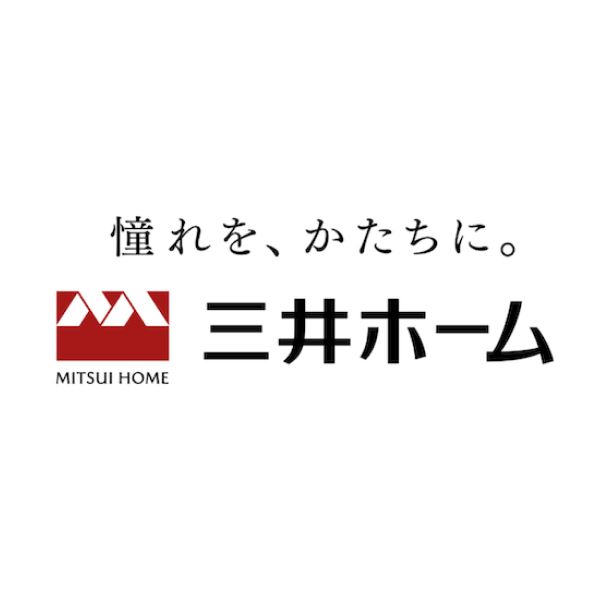
- Main construction type: Wooden
- Budget range: Middle ~ High
Mitsui Home is a group company of Mitsui Fudosan (三井不動産), offering a wide range of design options from modern to classic.
Mitsui Home offers its unique technology called the "Premium Monocoque Construction Method (プレミアム・モノコック構法)" a wooden wall construction method. The company offers good earthquake resistance and thermal insulation.
On the other hand, the price is slightly higher than other house-makers, and it may not be a wise option for people whose #1 priority is the cost.
4-8. Asahi Kasei Homes / Hebel Haus (旭化成ホームズ / ヘーベルハウス)
Popular for steel frame houses with high durability and earthquake resistance.

- Main construction type: Steel Frame
- Budget range: High
Hebel Haus mainly handles steel-framed houses. The main selling points of Hebel Haus are durability and earthquake resistance, as it uses heavy steel instead of light steel. What are the types of steel frame houses ?
As Hebel Haus mainly uses heavy steel, the construction cost tends to be expensive. Also, there are some customer voices that the steel frame houses of Hebel Haus tend to get colder in the winter.
4-9. Ichijo Komuten (一条工務店)
High housing performance in a reasonable price range.
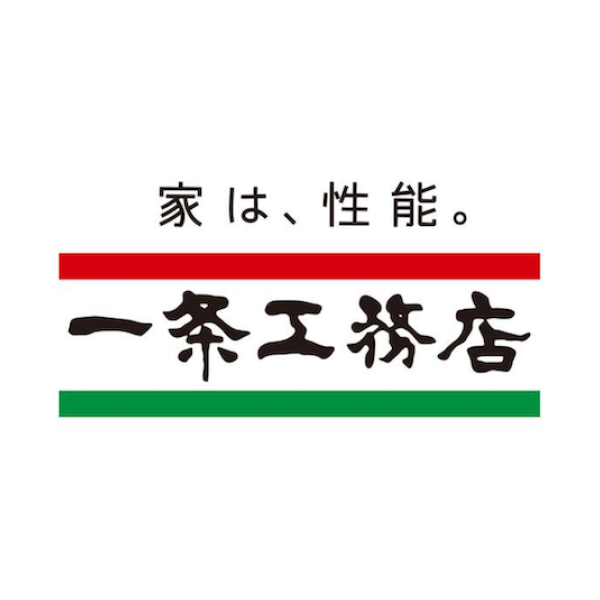
- Main construction type: Wooden
- Budget range: Middle
Ichijo Komuten focuses on the functionality of the house, including thermal insulation and earthquake resistance. Ichijo also manufactures many of its products in-house and keeps the cost low. You can also enjoy good energy-efficient functions from its offerings.
As Ichijo Komuten's focus is on functional performance of the house, it may not be a good choice for people who want to have good designs or flexible room plan development. If you can be satisfied with the products of Ichijo as it is sold, you will be able to get a house with good functionality at a reasonable price.
4-10. Panasonic Homes (パナソニックホームズ)
Unique design allows flexible floor plans even with steel frames.
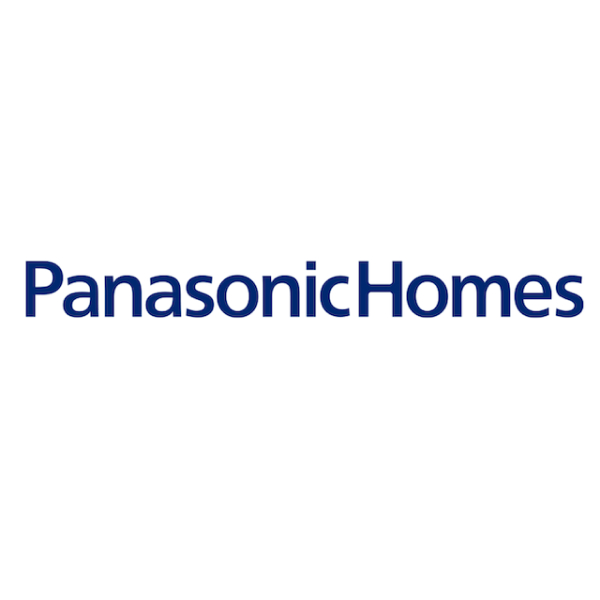
- Main construction type: Steel Frame
- Budget range: Middle
Panasonic Homes is the house building brand of Panasonic, a company famous for its home appliances. It mainly offers steel-framed houses, focusing on providing sturdy and comfortable homes.
A major feature of the houses of Panasonic Homes is that it is designed with a unique structure that allows for a flexible floor plan while providing earthquake resistance to withstand major earthquakes. It also has good energy-saving and energy-creating features, leveraging its capability as a group company of a large electronics company.
4-11. Toyota Home (トヨタホーム)
Features high-quality steel-frame houses with their technology foundation from the global automobile business.
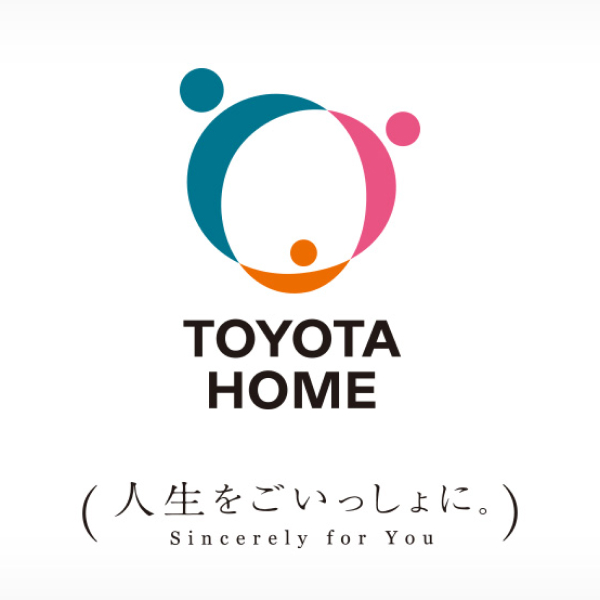
- Main construction type: Steel Frame
- Budget range: Low ~ Middle
Toyota Home is a group company of Toyota Motors, the global company famous for its automobiles. It is a house-maker that mainly handles steel-frame houses with high earthquake resistance. The company claims to build high-precision houses that can be lived in for a long time.
Toyota Home also features a long-term warranty of 40 years on the initial guarantee. The company claims it is backed by the rust-prevention technology it has acquired through automobile manufacturing experience.
It may have limited flexibility in the room plans when it comes to the designs of the house.
4-12. Eyeful Home / LIXIL Group (アイフルホーム / LIXIL グループ)
LIXIL Group house builder with nationwide franchises

- Main construction type: Wooden
- Budget range: Low
Eyeful Home is a group company of the LIXIL brand, a manufacturer of water and housing products. The company operates franchises throughout Japan, offering custom-built homes at affordable prices.
Eyeful Home also focuses on house designs that are friendly for the children, with specific features including soft cushions on the stairs and unique child-lock doors for bathrooms.
4-13. Aida Sekkei (アイダ設計)
Purchases and cuts lumber in-house. Affordable prices are achieved by eliminating intermediate costs.

- Main construction type: Wooden
- Budget range: Low
Aida Sekkei is a house-maker that has focused on building strong, long-lasting homes since its founding. The company reduces intermediate costs by integrating the entire process in-house, from lumber procurement to construction.
The company also emphasizes preventing price problems that are common in the housing industry. The company claims to offer honest explanations and honest estimates to create homes with integrity.
4-14. Sweden House (スウェーデンハウス)
Features imported wooden homes with Scandinavian designs.
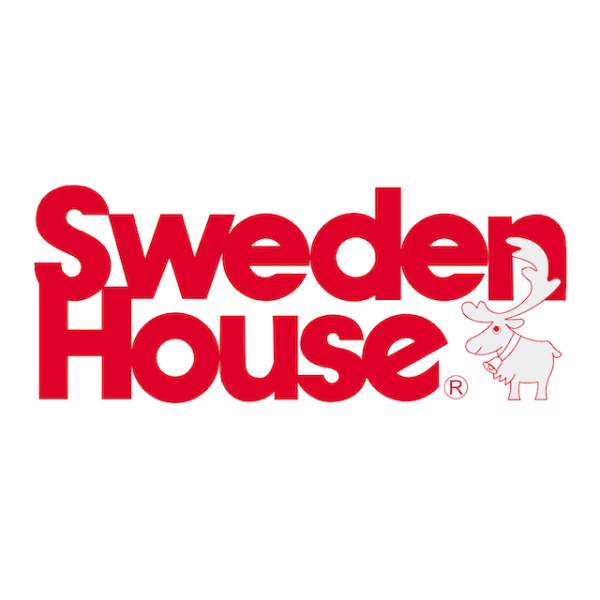
- Main construction type: Wooden
- Budget range: Middle ~ High
Sweden House provides imported Scandinavian-style houses. The products offer high airtightness and insulation. Sweden House could be a good option for those who like scandinavian houses specifically.
The standard specifications of Sweden House's products are said to be compatible with long-term quality housing (長期優良住宅), with good heat insulation and airtightness. Sweden House has unique wooden frame windows but some customers find the disadvantages of those windows that it may not be the most suitable structure in Japan to avoid insects coming into the house.
4-15. Aqura Home (アキュラホーム)
Freedom in design and floor plans at an affordable price.

- Main construction type: Wooden
- Budget range: Low ~ Middle
Aqura Home is a house builder that aims to achieve more freedom in the designs at an affordable price. It focuses on delivering good designs compared to other low-cost house-makers.
As Aqura Home focuses more on designs and flexibility, it may not have as high functionalities as other house-makers. Also, you will need to check if they offer their service in your region as they only operate in 13 prefectures* including Tokyo and Osaka.
(* information as of December 2022)
4-16. Cleverly Home (クレバリーホーム)
Unique exterior tiles with low maintenance costs.
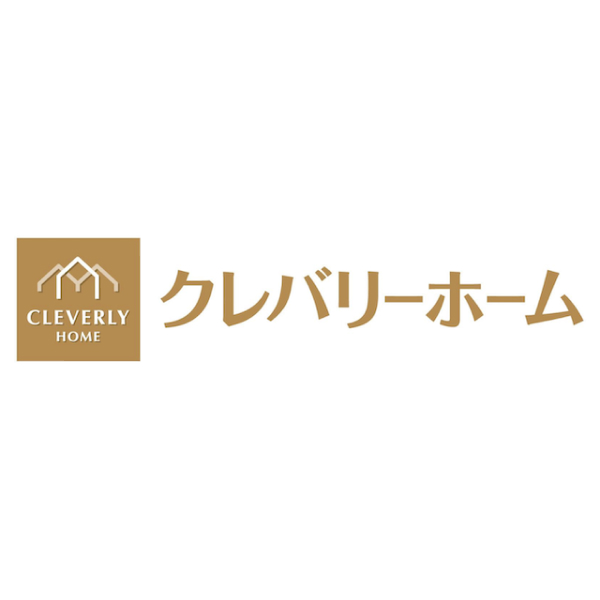
- Main construction type: Wooden
- Budget range: Low
Cleverly Home mainly builds wooden houses throughout Japan. The company is famous for its unique offerings of high-quality exterior tiles, with strong endurance against rain and dirt.
The unique construction method makes it highly earthquake resistant as a standard feature. Some customers on the internet say they did not have the most successful experience with the sales representatives.
4-17. Universal Home (ユニバーサルホーム)
Strength in high-performance floors with heating features.

- Main construction type: Wooden
- Budget range: Low
Universal Home offers wooden houses with a focus on the performance of the floors. It has many features to its floors, including floor heating and countermeasures to termites and floodings.
It offers low price housing compared to other house-makers. Some customers were not satisfied with the quality consistency of their sales representatives compared to other companies.
(5) Things to watch out for and 5 common pitfalls
We have inquiries from many clients who had some troubles with house-makers. Here are some examples of what you may encounter if you want to build a house with a house-maker.
The important thing is to have the right expectation - understanding the business model of house-makers and what the sales representatives are told to do. By having the right expectations, you can make the right decisions and avoid unnecessary troubles.
5-1. Construction cost increases over the budget you were initially told
You will not have to worry about this if you are not planning to make changes to the house that is shown in their product catalog. However, as you tell more and more wishes to the house-maker after the official engagement, many clients, unfortunately, encounter a material increase in the budget in the later process.
You will have to keep in mind that their business model is producing a "product" that will be accepted by as many people as possible in Japan, and the sales representative are, as the name says, people whose mission is to sell those products. The price usually will be maintained if you buy the "product" as it is but not if you want to make changes to it.
5-2. Limited flexibility
Since their business is built on its "standard" model of house products, you will not be able to freely customize the basic plans as you like.
For example, it will be difficult to materially change the size, the number of rooms, shape of the house, and other essential elements of your house. If you do, you will be facing a significant increase in the budget as you will not be able to enjoy the benefit of the business model of house-makers, which is the cost efficiency from the mass production of similar houses.
As the internal architect does not often come to your meetings, especially before an official signing and engagement, some people give up talking to the sales representative and go for another option; hire a builder (工務店) or an architect (建築家・設計事務所).
5-3. Not a true "custom design" house (注文住宅)
If you are thinking of your project to be a fully-customizable "Chumon Jutaku (注文住宅)" process with a house-maker, it may not be the case in many circumstances, even if they tell you it is.
When you will be choosing the elements of your house in the later phases, you are often given a menu with a few options to choose from, not being allowed to tell them what you want.
For example, you will only be able to choose your wallpaper from the 5 choices they give you, or you can only choose your kitchen from the 2 Japanese companies the house-maker has a close relationship with - not a Miele kitchen even if you love to cook, or not the beautiful one-of-a-kind product you found in a store.
It will not be fitting to their standardized plan and will tell you it will be extremely expensive if you want to choose something that is not on the menu.
5-4. Quality dispersion of sales representative
As there are some polite and trustworthy sales representatives, unfortunately, you sometimes can not avoid encountering a person who is not.
Typical troubles some clients had to face are;
- Inconsistency in what they tell you over time
- Slow responses and inaccurate communication
- Can not fully understand your wishes and does not proactively give new ideas
- Can not bring the internal architect to your important meetings
- Draws the initial design plans by themselves, not having an architect involved
What you need to keep in mind is that the people you will be talking to are the "sales" people who are selling the standardized products. They will be the right person to talk to if you don't need to discuss the details and just want to buy the house as it is shown in the catalog.
However, if you want to pay attention to the details or have a constructive discussion with a professional about your ideal house, it is most likely to be better to go to speak to an architect. 7 comparisons of your builder choices; house-maker, komuten, or an architect
5-5. Doesn't fit into the foreign lifestyle
As we described in this article, the business model of a house-maker is to build a standard house that will be accepted by the average household in Japan.
It is sometimes difficult for western people or families from other regions to find the house-makers' plans attractive in terms of the lifestyle it provides.
For example, Japanese households tend to prefer to have more small rooms over one open space. As the basic plans are difficult to change, it will be difficult to ask the house-maker to remove the walls and make a large living-dining space with an open feeling.
Another example is that Japanese people don't tend to prioritize their time in their gardens and balconies as much as people do in western countries. The basic models of house-makers may not have an attractive outside space or flexibility in designing your ideal environment.
(6) Summary
To recap this article, it will be important to choose the right house-maker based on the price range, the construction type, and the characteristics of each company.
Also, it is extremely important to review if house-makers are really the best choice for you. Although it will depend on each customer, people in Japan generally choose between house-makers, local builders, and architects based on the following criteria:
- If you want an easy process and prioritize construction speed, house-makers are your suitable choice. Please review the characteristics of the house-makers described in this article and investigate the ones you like.
- If you want to keep the cost as low as possible, it will generally make sense to go to a local builder as they offer similar services as house-makers but you don't need to pay for the marketing cost, which is generally around 40% of the construction cost with the house-makers.
- If you want to design freely or achieve higher functional performance than house-makers, it will make sense to hire an architect who can develop your own house from scratch at a similar budget.
japanese-architects.com is here to support your house building in Japan providing full English support. We offer a wide range of Japan-based architects with a proven track record and designing skills. We will connect you with the right and the best architect who matches your needs.
You can also contact us for free for a casual chat if you want to know which house-makers are your best choice. A professional will listen to your situation and provide honest feedback.
No fee, no risk. Just your name and email address.


